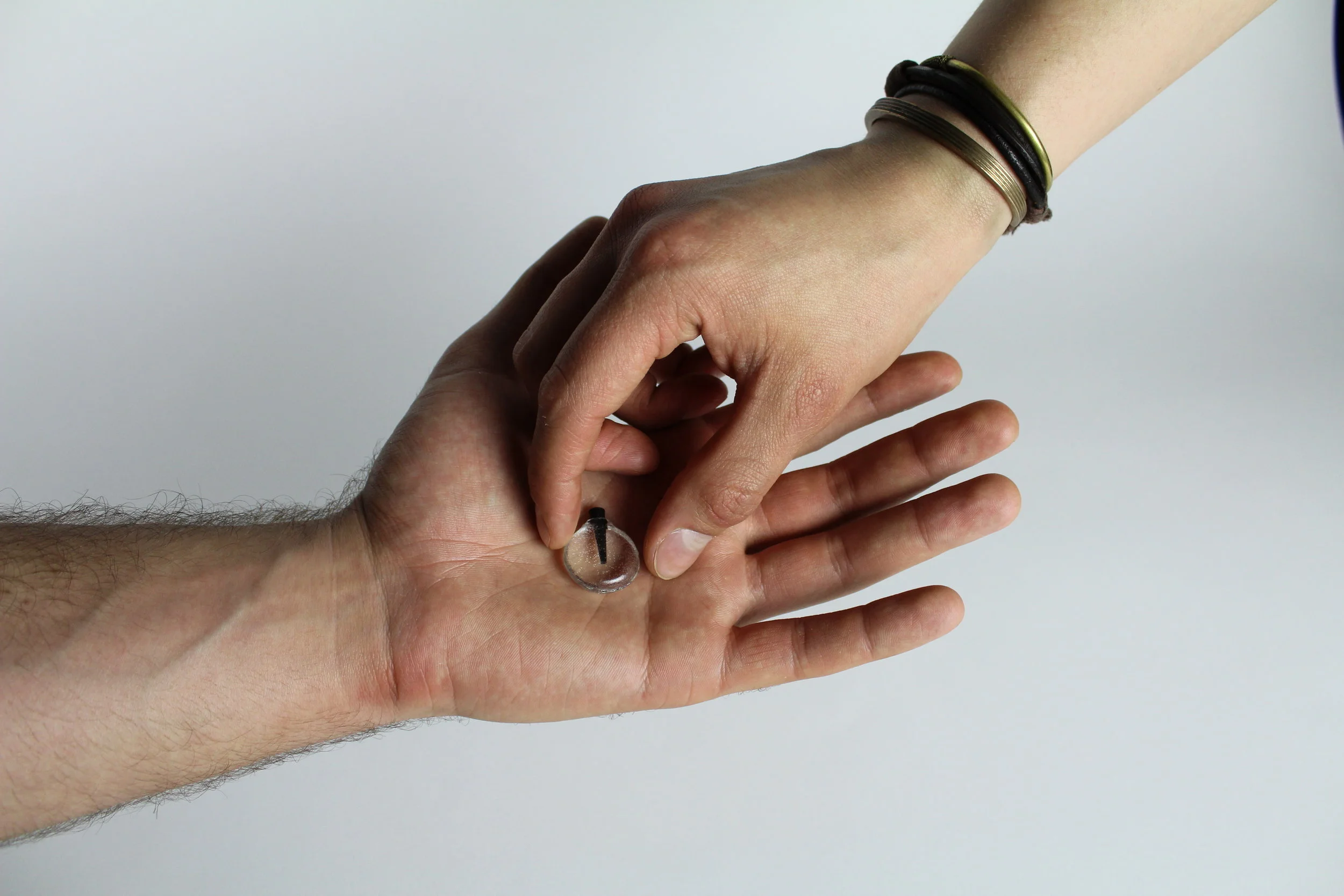eco-nomics
Included as part of artist/designer Alex Thompson’s ‘Token Economies’ show in May of 2019, ‘Eco-nomics’ asks society to consider three materials that will become extremely valuable soon if not valued by culture more than they are now. The materials are held in small hand made plastic vessels sized to be reminiscent of coinage. This small parcel of drinking water, sand, and milkweed seeds asks a viewer to consider these material’s unit sizes being minimized to fit in the palm of one’s hand.
Milkweed:
One of the most entrancing yet unappreciated material designs in action we encounter in daily life is that of a floating seed. Milkweed seeds, the quintessential white puffball that marks the end of summer in America, float effortlessly across fields in early fall. Simultaneously, Monarch butterflies migrate some 3,000 miles across the middle of America to Mexico for the winter. The journey is so long that it takes multiple generations of butterflies just to complete it. Normally, Monarchs lay their eggs on milkweed plants in open fields during their migration. Once the eggs hatch, the Monarch caterpillars eat the plant almost exclusively to grow strong enough to metamorphose and continue on. Unfortunately, increased herbicide use on American farms in the Midwest has become the leading cause of a decreasing availability of milkweed, and therefore a diminishing Monarch population. If we do not value this plant which has been cast aside so heavily as to have ‘weed’ in its own name, we will find that the Monarch butterfly population may make its way to zero.
Drinking Water:
In late 2017, Cape Town, South Africa was at the brink of becoming waterless. Had they reached ‘Day Zero,’ the day where the city’s reservoir ran completely dry, it would have been the first time in human history that a major city ran out of water. An aggressive campaign of water restriction citywide pulled Cape Town out of major risk almost right away. Since the risk of Day Zero until fall of 2018 Cape Town residents were limited to using 50L of water per day. According to a Guardian article about the crisis, Californians used 321 L of water daily in 2016.
Drought is only one threat to clean drinking water. Factors like pollution, overpopulation, and overconsumption put cheap clean water at risk of becoming much more expensive. In July of 2016, one gallon of New York City drinking water cost its residents .52 cents. Without more cultural value for clean drinking water, we may see this cost increase in the coming years.
Sand:
Sand is essential in the formation of concrete through its faceted grains. The facets of each grain of sand create a surface area that allows the cement to bind together and form into a stable block. As urbanization and population have both been increasing, our demand for concrete and therefore sand has increased as well. We are building so many new cities that we are actually managing to run low on sand.
Contrary to popular belief, the ocean is not full of sand. It is almost entirely rock on the bottom. While the desert is full of sand, only ocean sand can be used in the formation of concrete as desert sand is not faceted like ocean sand is and so cannot create the same cohesion that ocean sand can. We have now begun dredging for sand in rivers and near shores around the world. As a result, beaches are receding at a noticeable rate and ecosystems are suffering from the plumes of sand dust being kicked up below the surface.
Humans are suffering from the sand shortage as well. In India, there are sand wars so heated that people are being killed in the name of illegal sand mining. Beaches are stolen overnight, shoveled into dump trucks and driven away. The business of stealing sand has become so lucrative that India is now home to a ’Sand Mafia.’ If sand supplies get low enough, there is more to consider than whether we will still have beaches to escape to in the summers. The real question to consider is how will we be housing our growing urban population without the most essential ingredient required for basic building structures.
Sources:
Beiser, Vince. “The Deadly Global War for Sand.” Wired, Conde Nast, 19 July 2018, www.wired.com/2015/03/illegal-sand-mining/.
Leahy, Stephen. “Half of All Land Must Be Kept in a Natural State to Protect Earth.” National Geographic, 19 Apr. 2019, www.nationalgeographic.com/environment/2019/04/science-study-outlines-30-percent-conservation-2030/.
Mahr, Krista. “How Cape Town Was Saved from Running out of Water.” The Guardian, Guardian News and Media, 4 May 2018, www.theguardian.com/world/2018/may/04/back-from-the-brink-how-cape-town-cracked-its-water-crisis.
Smith, Lindsay N. “Monarch Butterfly's Reign Threatened by Milkweed Decline.” National Geographic, National Geographic Society, 17 May 2016, news.nationalgeographic.com/news/2014/08/140819-monarch-butterfly-milkweed-environment-ecology-science/.
“Water and Sewer Rate.” NYC 311, www1.nyc.gov/nyc-resources/service/2703/water-and-sewer-rate.



